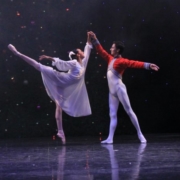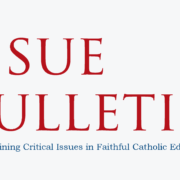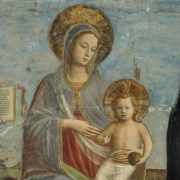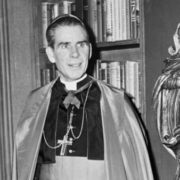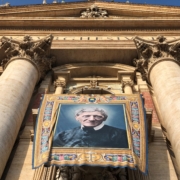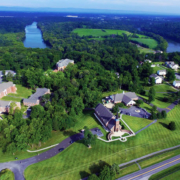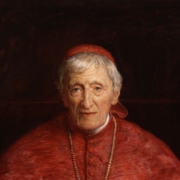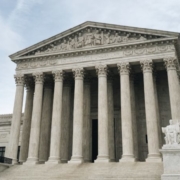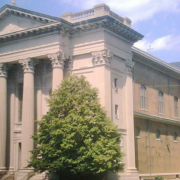Half a century into a sexual revolution that has upturned notions of sexual morality and even gender identity, Catholic education is under attack like never before. Religious schools and colleges are facing protests and lawsuits, while presidential candidates are promising to revoke schools’ tax-exempt status—all because Catholic educators hold fast to Church teachings that were considered common sense even a decade ago.
Catholic schools and colleges have not sought out and do not want this confrontation. They exist to form young people to serve and worship God and to spread love and hope to others, rooted in the Church’s teaching on the dignity of the human person and God’s design for human sexuality. But educators are finding that, due to forces beyond their control, their freedom to operate according to conscience and mission is shrinking.
As legal and cultural pressures continue to swell, Catholic school leaders must decide now how they will respond. Many Catholic schools decided a long time ago to assimilate with changes in modern culture. Others have tried to placate critics by offering limited compromise to pressure from students, parents, or outsiders.
Instead, Catholic educators ought to take a different approach by viewing the current crisis as a call to deepen and strengthen their organizations’ religious identity.[1] The good news is that there is much that Catholic educators can do to help protect their ability to continue serving the public and operate according to mission. Despite the cultural trends, our nation has retained its strong founding commitment to religious liberty. But like Jesus, who has little patience for the lukewarm, the strongest religious liberty protections are available to those schools that communicate and live out their convictions—boldly, clearly, and consistently.
The first part of this Issue Bulletin provides context, illustrating some of the legal conflicts and other pressures on religious organizations from new and emerging standards in culture and law that conflict with their convictions.
The second part outlines practical steps that Catholic education leaders can take to prepare to meet these challenges. Most importantly, this part urges schools and colleges to undertake a mission audit that will help leaders identify where their convictions are likely to be challenged and help them better articulate their convictions in light of these challenges. The audit proposes a series of strategic decisions that help religious organizations understand present and anticipated conflicts, improve religious liberty protections, and prepare themselves for the challenges that may come.
The audit outlined here draws from the author’s experience working on such audits with dozens of Christian schools and major national Catholic ministries. This proven process not only improves legal defenses, it also helps invigorate the apostolate by giving community members a new and stronger sense of their calling and how they relate to the organization’s religious mission.
Religious liberty threats to Catholic education
To properly discern the path forward, Catholic school and college leaders must begin with a sober assessment of today’s cultural context and the legal pressures that are being brought to bear on religious organizations that are holding fast to Christian anthropology.[2]
The Supreme Court’s 2015 decision in Obergefell v. Hodges must feature prominently in any retelling of where Catholic educators in America find themselves today.[3] In one sense, the declaration that the Constitution protects the right to same-sex marriage was simply the latest in a long line of Supreme Court decisions, stretching back to Griswold v. Connecticut, 318 U.S. 479 (1965), that have developed a constitutional right to self-determine one’s sexual identity and sexual activity without consequences, a right that invariably is exercised by striking down laws and policies seeking to preserve the nuclear family and traditional sexual morality.[4]
Yet the Obergefell decision is much more than just another step down the same road the Supreme Court has been on for fifty years. It marked an important and ominous turning point in the relationship between sexual liberties and religious freedom. Rather than satisfying the cultural left, Obergefell has led to increasing hostility against Christian values and institutions that hold fast to their traditional views and resist cultural trends. Traditional views and even the concept of “religious liberty” itself have come under increasing attack.
In the years before Obergefell, the pitch for redefining marriage was often made on libertarian grounds. Same-sex couples were merely seeking a legal status that would give them hospital visitation rights[5] and alleviate tax penalties.[6] On the flip side, religious conservatives were pushed to answer how expanding marriage would affect their own lives.[7] The clear implication was that it would not at all.
But in June 2015, when the Supreme Court announced a constitutional right to same-sex marriage, the narrative changed abruptly and progressives began attacking religious institutions. The same day the Court dropped its opinion, the ACLU announced its opposition to religious freedom laws.[8] Two days later, The New York Times religion columnist Mark Oppenheimer called for an end to tax exemptions for religious institutions that disagree with the new public policy resulting from the Obergefell decision.[9]
The following year, the U.S. Commission on Civil Rights concluded a three-year study of the balance between religious liberty and nondiscrimination laws with a report, “Peaceful Coexistence: Reconciling Nondiscrimination Principles with Civil Liberties.” The Commission concluded that, for the most part, this “peaceful coexistence” will be achieved by forcing religious liberty claims to yield before emerging civil liberty claims.[10] The most incendiary part of the report is the statement of Commission Chairman Martin R. Castro, who said that “[t]he phrases ‘religious liberty’ and ‘religious freedom’ will stand for nothing except hypocrisy so long as they remain code words for discrimination, intolerance, racism, sexism, homophobia, Islamophobia, Christian supremacy or any form of intolerance. . . . This generation of Americans must stand up and speak out to ensure that religion never again be twisted to deny others the full promise of America.”[11]
The recent attacks on religious liberty have not been confined to rhetorical flourishes but have taken place in the courtroom as well. In many of these lawsuits, progressives have claimed the moral high ground by arguing that discrimination on the basis of sexual orientation or gender identity is akin to race discrimination. For example, in Craig v. Masterpiece Cakeshop, Christian baker Jack Phillips argued that he had not discriminated against a homosexual couple “because of” their sexual orientation, but because of their intended conduct—entering into a same-sex marriage.[12] The Colorado court rejected this argument. It said that while “Masterpiece thus distinguishes between discrimination based on a person’s status and discrimination based on conduct closely correlated with that status,” “the United States Supreme Court has recognized that such distinctions are generally inappropriate.”[13] In another Christian wedding vendor case, this time involving a florist, the Washington Supreme Court made a direct analogy to the civil rights era, asserting that “[w]e agree with [the plaintiffs] that this case is no more about access to flowers than civil rights cases in the 1960s were about access to sandwiches.”[14]
Many of these legal and cultural attacks have focused on faithful Catholic schools and colleges:
- In 2009, before the Obama administration implemented the HHS Mandate, the EEOC said that Belmont Abbey College, a Catholic liberal arts school near Charlotte, N.C., was guilty of sex discrimination because its employee health plan did not cover contraceptives.[15]
- In 2011, a Catholic school in Fort Wayne, Indiana, dismissed a junior high school language arts teacher, Emily Herx, when she continued with in vitro fertilization treatments after the pastor informed her that this violated Church teaching and asked her to stop. Ms. Herx alleged that this constituted sex discrimination, and the EEOC agreed. In December 2014, the jury found for Herx and awarded her $1.9 million in damages.[16]
- In 2014, a Catholic school in Macon, Georgia, dismissed its music teacher after he announced on Facebook his upcoming same-sex wedding. In March 2015, the EEOC determined that this was sex discrimination under Title VII. On June 29, the day after the Obergefell decision, the plaintiff filed his Title VII lawsuit against the Catholic school.[17]
- In 2016, the California Assembly took up proposed legislation, SB 1146, that aimed at stigmatizing and punishing religious colleges and universities that expect their students to adhere to the school’s traditional beliefs on sexual identity and sexual morality. The bill, in its strongest form, opened up such religious schools to civil lawsuits from LGBT students and blocked students who wanted to attend such schools from receiving Cal Grants, California’s need-based aid system.[18] The bill’s sponsor, California Senator Ricardo Lara, wanted “to shed light on the appalling and unacceptable discrimination against LGBT students at these private religious institutions throughout California.” Another California legislator, Assemblyman Evan Low, called colleges claiming a religious exemption from Title IX “the worst of the worst in terms of institutions that discriminate.”
The attacks on faithful Catholics have only intensified over the past year:
- In late 2018, Democrats in the Senate Judiciary Committee contended that a judicial nominee should be rejected simply because he belonged to the Knights of Columbus.[19]
- In May 2019, the House of Representatives passed the “Equality Act,” a bill that would make it illegal to discriminate on the basis of “sexual orientation” or “gender identity” while eliminating religious liberty protections.[20] Fortunately, the bill died in the Senate.
- In September, Secretary of Education Betsy DeVos came under attack for visiting a Catholic school in Pennsylvania that is not inclusive of transgender students and staff and has a strict policy against “sex reassignment.”[21]
- In October, presidential candidate Beto O’Rourke called for stripping churches and schools of their tax-exempt status if they oppose same-sex marriage.[22]
- Also in October, the Supreme Court heard three cases that ask the Court to redefine “sex discrimination” under Title VII, the federal employment nondiscrimination law, to include both “sexual orientation” and “gender identity.” The Supreme Court is expected to decide these cases by June 2020.[23]
In 2019 alone, Catholic schools have faced lawsuits for terminating employees for premarital sex,[24] entering a same-sex union,[25] and for publicly advocating for same-sex couples.[26] Leaving aside school-teacher conflicts, Catholic schools have faced backlashes within the Catholic community for refusing admission to the child of a same-sex couple[27] and for refusing to celebrate a same-sex wedding in the campus chapel.[28]
Catholic education leaders must decide now how they will respond to this crisis.
As these pressures mount, Catholic educators must decide now how they will respond to the aggressive pressures being brought to bear on religious institutions that hold fast to their convictions. School and college leaders with little appetite for conflict or budget for protracted litigation will likely prefer an approach that would allow them to sidestep these conflicts. But the options here are not promising. Instead, Catholic educators are urged to undertake a mission audit to help them develop and implement strategies to strengthen their religious identity and their religious liberty defenses.
Attempts to avoid conflict are either futile or involve compromises inconsistent with the mission of a Catholic school.
Catholic school and college leaders would rather focus on education and evangelism than on costly and time-consuming legal and public relations battles. But there are good reasons to think that efforts to avoid conflict or placate the Church’s critics are either impractical or unprincipled.
One option, to simply agree to conform policies and personnel matters to the emerging consensus, is a non-starter for schools and colleges that take seriously the mission of Catholic education as articulated by Vatican II and recent popes.[29] Nor is it realistic for Catholic educators to simply hope that this cultural moment will pass them by without incident. Underlying this reality, the 2019 lawsuits mentioned above were filed in Kansas and Indiana, Midwestern states far from the coasts.
Another option would be to make some compromises with the culture in the hopes of brokering a peace. The pervasive attacks on traditional moral teaching have led some religious leaders to try to compromise and thereby win some good will from gender and sexuality activists. Mormon and Evangelical leaders have tried this approach in recent years, with decidedly mixed results. In 2015 the Mormon Church threw its weight behind the “Utah Compromise,” an attempt to broker a truce in the culture war by pairing new civil rights protections with religious-liberty protections for faith-based organizations.[30] At the end of 2018, major Evangelical Christian groups—including the Council for Christian Colleges and Universities and the National Association of Evangelicals—endorsed their own version of this compromise approach under the slogan “Freedom for All.” Here, as in Utah, the policy of giving progressives some of what they wanted was sold as a political strategy to preserve religious liberty.[31] One supporter described the effort in these terms:
As Christian higher educators, we are increasingly persuaded that the most viable political strategy is for comprehensive religious freedom protections to be combined with explicit support for basic human rights for members of the LGBT community.[32]
So far, however, there is little reason to call the “Fairness for All” approach a success. While progressive activists celebrated what they were able to accomplish in Utah, they quickly signaled that it was not enough, and that they would push for more whenever they had the opportunity.[33] Advocates specifically complained that the “Utah Compromise” yielded too much so-called “religious liberty.” As noted above, the left has come to see “religious liberty” as a code word for bigotry; there is no reason to think that religious conservatives can change people’s minds on this by compromising on nondiscrimination law.
Some Catholic universities have also demonstrated the weakness and futility of the compromise approach to these culture war battles over sexual morality. The University of Notre Dame has extended spousal benefits to same-sex partners[34] and covers most FDA-approved contraceptives in its health plans,[35] yet it was still sued for refusing to fund abortifacients[36] and its student body president is calling for the school to abandon single-sex dorms and parietals on the basis that they are “heteronormative” and discriminate against transgender and same-sex attracted students.[37] Marquette University hosts a student “Pride Prom”,[38] yet like Notre Dame is still facing pressure over its “outdated” single-sex dorm policies.[39]
If compromising Catholic principles in order to placate progressive critics is a flawed political strategy, it is perhaps an even worse legal strategy. At one point, Notre Dame told a federal judge that, consistent with Ex Corde Ecclesiae, it was prohibited from paying for, providing, or facilitating access to contraceptives.[40] But in 2014, the University reversed course and voluntarily began complying with the HHS Mandate.[41] This sort of inconsistency invites courts to probe as to whether a school’s stated religious convictions are sincere, a key inquiry in religious liberty cases. Perhaps even worse, it encourages protestors and plaintiffs by giving them reason to hope that Catholic institutions will cave if only the heat is turned up hot enough.
Catholic schools and colleges are instead urged to undertake a mission audit to strengthen their religious identity and religious liberty defenses.
Rather than trying to appease the Church’s critics, Catholic organizations should instead look to clarify and strengthen their religious identity. This is the best way for Catholic schools and colleges to embrace their distinctive mission. In his 2008 address to Catholic educators at The Catholic University of America, Pope Benedict XVI identified an “educational emergency” and urged leaders to fulfill the mission of Catholic education:
A particular responsibility, therefore, for each of you and your colleagues, is to evoke among the young the desire for the act of faith, encouraging them to commit themselves to the ecclesial life that follows from this belief. It is here that freedom reaches the certainty of truth. In choosing to live by that truth, we embrace the fullness of the life of faith which is given to us in the Church.[42]
As The Cardinal Newman Society has stressed, the Church calls Catholic educators “to remain vigilant in their mission” by resisting the temptation to conform to the world. Schools and colleges must do this “by preserving a Catholic culture which proclaims essential truths about the nature and dignity of the human person.”[43]
Fortunately, this ecclesial mandate is also a strong and wise legal strategy. While the challenges facing churches and religious organizations are daunting, our nation’s bedrock commitment to religious liberty remains strong. This historical commitment continues to live in the First Amendment’s protections for religious and expressive freedom, broad religious liberty statutes, and specific exemptions found in a number of laws.[44]
In order to best protect their religious liberty, it is imperative that Catholic schools and colleges understand and take full advantage of these protections. To do so, Catholic educators should undertake a mission audit to help them understand where they are likely to face challenges and to ensure that they have an architecture in place to protect their freedom to minister and work in accordance with their faith.
Just as a general audit helps an organization understand its financial soundness, a mission audit will help a religious organization understand how its religious convictions affect its work and how these convictions may face conflict. The proposed mission audit outlines the kind of practical steps religious institutions can take to avoid such conflicts, improve their ability to claim religious liberty protections, and prepare themselves for potential challenges.
Often organizations are initially motivated to undertake a religious mission audit for defensive reasons: because they are acutely aware that distinctly Christian educators and employers are in legal and cultural crosshairs and want to know how to best protect their institution and its mission against attacks. But the audit has positive aspects as well. Over the past six years, our firm’s religious institutions group has helped dozens of Christian schools, several dioceses, and large religious organizations through this audit process to help them strengthen their legal protections by strengthening their religious identity. In our experience, religious organizations find the audit process revealing and instructive. The process helps Catholic schools and colleges:
- Better articulate their charism inside and outside their community;
- Clarify and implement this charism as it relates to their various programs, departments, and positions; and
- Better steward their school’s charism and resources.
- Quick steps to protect mission
Many school and college leaders see the need for a mission audit but want to know what steps they should be taking in the short term. The mission audit we recommend begins with getting leaders around a table to make sure they have clarity about their mission and convictions.
Building on this consensus, leaders should ask some high-level questions to get a sense about what they need in order to accomplish their mission and whether documents and policies adequately convey these requirements. The most important areas to review are employee expectations, student expectations, nondiscrimination statements, and facilities use policies. Schools may also want to make sure they understand the nondiscrimination requirements they are subject to through professional or extracurricular organizations like sports leagues.
In undertaking this overview, school leaders may find it helpful to refer to guides that have been prepared and made available by religious liberty groups.[45]
- Mission audit overview
While publicly available guides and templates can be a good start, most schools and colleges should invest in a more detailed and individualized strategy. Every organization’s circumstances are different, and sophisticated entities should not entrust their legal exposure to an online resource any more than they would forego individualized financial advice.
Each organization’s process will need to take into account the challenges in its locality, as well as the religious liberty provisions specific to the organization type and location. The audit outlined below is a sizable undertaking, but such planning is necessary as a matter of stewardship and prudent leadership. While each such audit must be tailored to the particular entity, every organization’s process should involve three basic steps.
a. STAGE ONE: Clarifying the audit’s scope and objectives
The first step in the audit process is for school and college leaders, together with legal counsel, to discuss the institution’s general concerns and establish the scope of the audit. Most mission audits should address the following subject areas:
- Corporate Documents
- Is the school or college taking advantage of available opportunities to establish its identity as a religious organization under relevant laws?
- Public Accommodations
- Does the school or college have policies and procedures for facility use and rental? If so, does its process properly balance reasons for renting its facilities with its ability to control how the campus is used?
- Nondiscrimination Policies
- Do nondiscrimination policies—in handbooks, policy manuals, and elsewhere—accurately reflect how the school or college makes decisions?
- Student Conduct Issues
- Do promotional materials, enrollment process, student handbook, disciplinary process and procedures, etc., appropriately communicate and secure consent regarding the community’s standards and their connection to the religious identity of the school or college?
- Employee Conduct Issues
- Does the school or college understand how available religious liberty protections apply to each position? Has it laid the proper groundwork so that it is able to invoke available religious liberty protections when necessary?
- Sexual Abuse
- Do policies and procedures for handling allegations of sexual abuse or misconduct reflect best practices? Is the school or college well-positioned to handle allegations in a manner that balances justice and mercy and that prepares it to address related public relations and legal challenges?
b. STAGE TWO: Audit current policies and procedures
The second stage of the audit involves reviewing how the school or college operates at present. The audit usually begins with a document review and continues with follow-up questions and conversations. A thorough document review typically involves the following:
- Corporate documents;
- Human resources documents;
- Student-related documents;
- Sexual abuse policies and procedures;
- Facility rental policies and procedures; and
- Documents related to third-party obligations, including sports leagues, grants, and government contracts.
c. STAGE THREE: Developing recommendations to protect the organization
While the first two stages of the audit help a school or college understand where it stands, this final stage is the most important. Here, educators will identify and implement strategies to help them continue to pursue their mission despite the present and emerging threats to religious liberty.
The first goal is to identify obstacles that can be avoided. The school or college could seek to:
- Eliminate unnecessary legal conflicts;
- Eliminate peripheral activities;
- Reduce dependence on government funding; or
- Reduce oversight from licensing or accrediting organizations.
For those conflicts that are not easily avoidable, religious organizations should work to improve their ability to claim crucial protections for religious liberty. By one scholar’s count, there were 2,000 religious exemptions in state and federal law in 1992.[46] The audit should help educators identify the religious liberty protections most relevant to their activities and identify ways to reshape policies, practices, and documentation in light of these protections.
Here the audit will aim to:
- Strengthen or clarify the school’s or college’s relationship to its religious tradition or to a religious authority;
- Clarify the organization’s status as an “expressive association;” and
- Strengthen the educators’ ability to claim exemptions from employee discrimination laws (including the ministerial exception, Title VII’s bona fide occupational qualification, and Title VII’s religious organization exception).
Finally, the audit recommends ways for the school or college to avoid controversy. While positioning itself to qualify for religious liberty protections, a religious organization should not overlook some simple, practical things it can do to avoid controversy. It should do everything it can to treat employees well and to apply moral standards consistently.
Conclusion
Undertaking a mission audit is a crucial task for Catholic schools and colleges today. This Issue Bulletin has explained why a Catholic school or college should undertake an assessment that will help identify challenges and religious liberty protections specific to its locale and activities and then make adjustments to better protect itself from challenges. Failure to act promptly to identify and address legal and institutional weaknesses can have enormous consequences for Catholic educators’ ability to fulfill their calling.
While a thorough audit is a time-intensive and resource-intensive process, such planning is necessary in today’s environment as a matter of stewardship and prudent leadership. To reduce the cost of the audit, many schools and colleges choose to undergo an audit with others that they recognize as peers. This approach not only saves money, but it also helps schools and colleges learn from each other’s insights, struggles, and successes.
Catholic educators should carefully choose the legal counsel that will guide them through this process. A thorough mission audit is best undertaken with counsel that is familiar with religious organizations and with religious liberty issues, as such familiarity will help guide the school or college through the complex moral, religious, and practical problems facing religious education today.
Eric Kniffin is an attorney in Colorado Springs, Colorado specializing in religious institutions. He is a partner with the law firm of Lewis Roca Rothgerber Christie LLP and can be reached at 719-386-3017 or ekniffin@lrrc.com.
[1] DISCLAIMER: This paper should not be construed as legal advice or legal opinion on any specific facts or circumstances. The contents are intended for general informational purposes only, and readers are urged to consult their own lawyers concerning particular situations and any specific legal questions they may have.
[2] For a more detailed survey of the cultural and legal threats against Christian institutions in the wake of Obergefell v. Hodges, see Eric N. Kniffin, Protecting Your Right to Serve: How Religious Ministries Can Meet New Challenges without Changing Their Witness, Heritage Foundation (Nov. 9, 2015) at 3-7, https://www.heritage.org/civil-society/report/protecting-your-right-serve-how-religious-ministries-can-meet-new-challenges.
[3] 135 S. Ct. 2584, 2594 (2015).
[4] For a helpful overview of this line of Supreme Court cases and the sexual revolution, see Helen Alvaré, Religious Freedom Versus Sexual Expression: A Guide, 30 J. L. & Religion 475 (2015). See also Helen Alvaré, With Power Comes Responsibility: The Rise of Sexual Expressionism and the Decline of Children’s Interests, Cambridge Univ. Press (2017).
[5] See Human Rights Campaign, Hospital Visitation Guide for LGBTQ Families, https://www.hrc.org/resources/hospital-visitation-guide-for-lgbt-families
[6] Bill Mears, Same-sex marriage and DOMA: 5 things we learned from oral arguments, CNN (March 28, 2013), https://www.cnn.com/2013/03/27/us/new-york-doma-windsor/index.html
[7] See Ethics & Religious Liberty Comm’n, How will gay marriage impact your marriage? (Aug. 4, 2014), https://erlc.com/resource-library/articles/how-will-gay-marriage-impact-your-marriage.
[8] Louise Melling, ACLU: Why we can no longer support the federal ‘religious freedom’ law, Washington Post (June 26, 2015), http://www.washingtonpost.com/opinions/congress-should-amend-the-abusedreligious-freedom-restoration-act/2015/06/25/ee6aaa46-19d8-11e5-ab92-c75ae6ab94b5_story.html.
[9] Mark Oppenheimer, Now’s the Time to End Tax Exemptions for Religious Institutions, Time (June 28, 2015), http://time.com/3939143/nows-the-time-to-end-tax-exemptions-for-religious-institutions/.
[10] U.S. Commission on Civil Rights, Peaceful Coexistence: Reconciling Nondiscrimination Principles with Civil Liberties (Sept. 7, 2016), http://www.usccr.gov/pubs/Peaceful-Coexistence-09-07-16.PDF.
[11] Id. at 29.
[12] 370 P. 3d 272, 280 (Colo. App. 2015).
[13] Id. at 280-81 (collecting cases).
[14] State v. Arlene’s Flowers, Inc., No. 91615-2, 2017 WL 629181, at *16 (Wash. Feb. 16, 2017) (quotation and alteration omitted).
[15] Charlotte Allen, The Persecution of Belmont Abbey (Oct. 26, 2009), https://www.washingtonexaminer.com/weekly-standard/the-persecution-of-belmont-abbey.
[16] Rebecca S. Green, “Jury sides with fired teacher,” The Journal Gazette (Dec. 20, 2014), http://www.journalgazette.net/news/local/courts/Jury-sides-with-fired-teacher-4094706; Herx v. Diocese of Fort Wayne-South Bend, Inc., 48 F. Supp. 3d 1168 (N.D. Ind. September 13, 2014) (denying diocese’s ministerial exception defense).
[17] Dr. Susan Berry, Gay teacher files federal discrimination lawsuit against Catholic school, Brietbart (July 1, 2015), http://www.breitbart.com/big-government/2015/07/01/gay-teacher-files-federal-discrimination-lawsuit-against-catholic-school/.
[18] See California Legislative Information, SB-1146 Discrimination: postsecondary education, Bill Analysis, Aug. 1, 2016, https://leginfo.legislature.ca.gov/faces/billAnalysisClient.xhtml?bill_id=201520160SB1146#; Jane Adams, California bill takes aim at religious colleges that seek to bar transgender students, EdSource (May 31, 2016), https://edsource.org/2016/california-bills-take-aim-at-religious-colleges-that-seek-to-bar-transgender-students/564869.
[19] Ed Condon, Judicial nominee faces Senate scrutiny over Knights of Columbus membership, Catholic News Agency (Dec. 21, 2018), https://www.catholicnewsagency.com/news/senators-quiz-nominee-about-membership-of-extreme-knights-of-columbus-78683
[20] Despite religious freedom concerns, House passes Equality Act, Catholic News Agency (May 17, 2019), https://www.catholicnewsagency.com/news/despite-religious-freedom-concerns-house-passes-equality-act-71069.
[21] Caitlin O’Kane, Secretary of Education Betsy DeVos visits school with anti-transgender policy, CBS News (Sept. 19, 2019), https://www.cbsnews.com/news/betsy-devos-education-secretary-transgender-school-visiting-harrisburg-catholic-policy-transgender-students/.
[22] Tobias Hoonhout, Beto O’Rourke Calls for Stripping Churches of Tax-Exempt Status If They ‘Oppose Same-Sex Marriage’, National Review (Oct. 11, 2019), https://www.nationalreview.com/news/beto-orourke-calls-for-stripping-churches-of-tax-exempt-status-if-they-oppose-same-sex-marriage/.
See also Eric Kniffin’s recent interviews with Drew Mariani: Drew Mariani Show, Beto O’Rourke Proposes Yanking Tax Status on Churches (Oct. 11, 2019), https://relevantradio.com/2019/10/beto-orourke-proposes-yanking-tax-status-on-churches/; Drew Mariani Show, Religious Liberty and the 2020 Presidential Election (Nov. 11, 2019), https://relevantradio.com/2019/11/is-a-new-democratic-candidate-jumping-in/.
[23] Adam Liptak, Supreme Court Considers Whether Civil Rights Act Protects L.G.B.T. Workers, NY Times (Oct. 8, 2019), https://www.nytimes.com/2019/10/08/us/politics/supreme-court-gay-transgender.html.
[24] Associated Press, Former Kansas City Catholic school teacher says she was fired for being pregnant and unmarried, KMBC News (Aug. 20, 2019), https://www.kmbc.com/article/former-kansas-city-catholic-school-teacher-says-she-was-fired-for-being-pregnant-and-unmarried-michelle-bolen/28759819#.
[25] Arika Herron, Cathedral fired a gay teacher. Brebeuf protected one. They are married to each other, lawyer says, Indianapolis Star (July 10, 2019), https://www.indystar.com/story/news/education/2019/07/10/cathedral-teacher-fired-same-sex-marriage-sues-indianapolis-archdiocese-identifies-himself/1694669001/.
[26] Mary Farrow, Archdiocese faces third discrimination complaint over same-sex marriage policy, Catholic News Agency (Oct. 29, 2019), https://www.catholicnewsagency.com/news/archdiocese-faces-third-discrimination-complaint-over-same-sex-marriage-policy-48517.
[27] Christine Hauser, Catholic School in Kansas Faces a Revolt for Rejecting a Same-Sex Couple’s Child, The New York Times (March 8, 2019), https://www.nytimes.com/2019/03/08/us/kansas-catholic-school-same-sex-parents.html.
[28] Thomas O’Neil-White, D’Youville grad says college denied her same-sex wedding, WBFO 88.7, (Oct. 21, 2019), https://news.wbfo.org/post/dyouville-grad-says-college-denied-her-same-sex-wedding.
[29] See Cardinal Newman Society, Church Vision for Catholic Education, https://cardinalnewmansociety.org/church-vision-catholic-education/.
[30] Laurie Goodstein, Utah Passes Antidiscrimination Bill Backed by Mormon Leaders, The New York Times (March 12, 2015), https://www.nytimes.com/2015/03/12/us/politics/utah-passes-antidiscrimination-bill-backed-by-mormon-leaders.html.
[31] J.C. Derrick, Boards back SOGI compromise, World Magazine (Dec. 12, 2018), https://world.wng.org/2018/12/boards_back_sogi_compromise.
[32] Id.
[33] Zack Ford, The ‘Utah Compromise’ Is A Dangerous LGBT Trojan Horse, ThinkProgress (Jan. 29, 2016), https://thinkprogress.org/the-utah-compromise-is-a-dangerous-lgbt-trojan-horse-db790ad3b69e/.
[34] Rosa Salter-Rodriguez, Notre Dame same-sex benefits rile bishop, The Journal Gazette (March 16, 2016), https://www.journalgazette.net/news/local/Notre-Dame-same-sex-benefits-rile-bishop–1U13HACU.
[35] Emma Green, Notre Dame Switches Its Position on Birth-Control Coverage – Again, The Atlantic (Feb. 7, 2018), https://www.theatlantic.com/politics/archive/2018/02/notre-dame-switches-its-position-on-contraception-coverage-again/552605/.
[36] Gina Cherelus, Notre Dame students sue school, White House over birth control policy, Reuters (June 26, 2018), https://www.reuters.com/article/us-usa-health-birth-control/notre-dame-students-sue-school-white-house-over-birth-control-policy-idUSKBN1JM2I9.
[37] Ellie Gardey, Student leaders fight “heteronormativity’ at Notre Dame, The College Fix (Sept. 16, 2019), https://www.thecollegefix.com/student-leaders-fight-heteronormativity-at-notre-dame/.
[38] Caroline White, Marquette’s Pride Prom to go on as planned despite backlash, petition, National Catholic Reporter (April 13, 2018), https://www.ncronline.org/news/people/marquettes-pride-prom-go-planned-despite-backlash-petition.
[39] Antiquated housing policies cause stress, burdens, MarquetteWire (Oct. 8, 2019), https://marquettewire.org/4018762/opinion/editorial-antiquated-housing-policies-cause-stress-burdens/.
[40] Univ. of Notre Dame v. Sebelius, 988 F. Supp. 2d 912, 915 (N.D. Ind. 2013).
[41] Joan Frawley Desmond, Notre Dame’s Student Health Plan Will Cover Contraceptives, Abortifacients, National Catholic Register (Sept. 4, 2014), http://www.ncregister.com/daily-news/notre-dames-student-health-plan-will-cover-contraceptives-abortifacients.
[42] Pope Benedict XVI, Meeting with Catholic Educators (April 17, 2008), http://w2.vatican.va/content/benedict-xvi/en/speeches/2008/april/documents/hf_ben-xvi_spe_20080417_cath-univ-washington.html.
[43] Cardinal Newman Society, Catholic Identity in Education: Selected Church Documents for Reflection, https://cardinalnewmansociety.org/principles-catholic-identity-education/church-documents-reflection/.
[44] For an overview of these religious liberty protections, see Kniffin, Protecting Your Right to Serve at 9-13.
[45] See, e.g.:
[46] Douglas Laycock, Regulatory Exemptions of Religious Behavior and the Original Understanding of the Establishment Clause, 81 Notre Dame L. Rev. 1793, 1837 (2006) (citing James E. Ryan, Smith and the Religious Freedom Restoration Act: An Iconoclastic Assessment, 78 Va. L. Rev. 1407, 1445 & n.215 (2015)).

